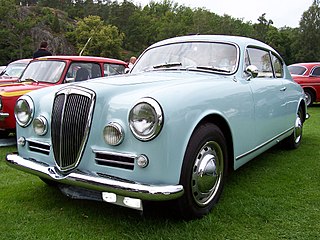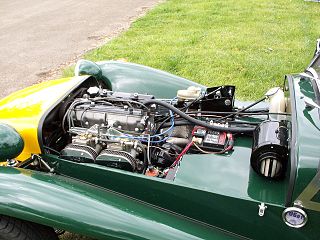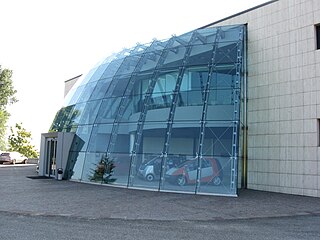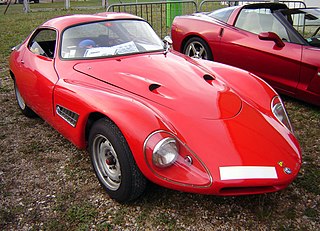
Abarth & C. S.p.A. is an Italian racing- and road-car maker and performance division founded by Italo-Austrian Carlo Abarth in 1949. Abarth & C. S.p.A. is owned by Stellantis through its Italian subsidiary. Its logo is a shield with a stylized scorpion on a yellow and red background.

A grand tourer (GT) is a type of car that is designed for high speed and long-distance driving with performance and luxury. The most common format is a front-engine, rear-wheel-drive two-door coupé with either a two-seat or a 2+2 arrangement. Grand tourers are often the coupé derivative of luxury saloons or sedans. Some models, such as the Ferrari 250 GT, Jaguar E-Type, and Aston Martin DB5, are considered classic examples of gran turismo cars.

Zagato is a coachbuilding company founded by Ugo Zagato in 1919. The design center of the company is located in Terrazzano, a village near Rho, Lombardy, Italy.

The Alfa Romeo 164 is a four-door executive saloon manufactured and marketed by Italian automaker Alfa Romeo from 1987 to 1998, styled by Pininfarina, and cooperatively designed and sharing platforms and numerous elements with the Fiat Croma, Saab 9000 and Lancia Thema.

The Alfa Romeo 155 is a compact executive car produced by Italian automobile manufacturer Alfa Romeo between 1992 and 1998. It was unveiled in January 1992 at Barcelona, with the first public launch in March 1992, at the Geneva Motor Show. A total of 195,526 units were made before it was replaced by the 156.

The Fiat Twin Cam is an advanced double overhead camshaft inline-four automobile engine produced from 1966 through 2000 as a Fiat/Lancia engine. Designed by ex Ferrari engineer Aurelio Lampredi, the engine was produced in a large number of displacements, ranging from 1.3 to 2.0 L and was used in Fiat, Lancia, Alfa Romeo, SEAT, FSO and Morgan cars. The Fiat Twin Cam engine has been widely used in motorsport and has been the most successful engine in the history of the World Rally Championship. Fiat and Lancia won a total of ten World Rally Championships for Manufacturers using engines based on the Lampredi Twin Cam engine. It was replaced by the Fiat "family B" Pratola Serra engine series.

Pininfarina S.p.A. is an Italian car design firm and coachbuilder, with headquarters in Cambiano, Turin, Italy. The company was founded by Battista "Pinin" Farina in 1930. On 14 December 2015, the Indian multinational Mahindra Group acquired 76.06% of Pininfarina S.p.A. for about €168 million.

The automotive industry in Italy is a quite large employer in the country, it had over 2,131 firms and employed almost 250,000 people in 2006. Italy's automotive industry is best known for its automobile designs and small city cars, sports and supercars. The automotive industry makes a contribution of 8.5% to Italian GDP.

The Ferrari GTO is an exotic homologation version of the Ferrari 308 GTB produced from 1984 until 1987 in Ferrari's Maranello factory. It was designated GT for Gran Turismo and O for Omologata.
The Turin Motor Show is an auto show held annually in Turin, Italy. The first official show took place between 21 and 24 April 1900, at the Castle of Valentino, becoming a permanent fixture in Turin from 1938 having shared it with Milan and Rome until that time. From 1972, the show was held biannually and in 1984, it moved into Fiat's shuttered Lingotto factory.

The Lancia LC2 was a series of racing cars built by Italian automobile manufacturer Lancia and powered by engines built by their sister company Ferrari. They were part of Lancia's official factory-backed effort in the World Sportscar Championship from 1983 to 1986, although they continued to be used by privateer teams until 1991. They were also the company's first car meeting the FIA's new Group C regulations for sports prototypes.

The Abarth 1000 GT Coupé or Alfa Romeo 1000 Abarth GT Bertone Coupé is a prototype car made by the Italian car producer Abarth in collaboration with Alfa Romeo, and designed by Franco Scaglione for Bertone. Three cars were built; one example survives, rebodied by Luigi Colani.
The Giro d'Italia automobilistico was an automobile race around Italy, historically first held in 1901, then reinstituted as annual event between 1973 and 1980, resurrected for 1988 and 1989, and again in 2011. Both in its historical and modern iterations the Giro d'Italia was inspired by its French equivalent, the Tour de France Automobile.

Nicola Materazzi was an Italian mechanical engineer who developed several sports and racing cars, including the Ferrari 288 GTO, Ferrari F40, Bugatti EB110, and B Engineering Edonis. He was one of Italy's leading turbocharging specialists from the mid-1970s, a respected sports car and motorcycle engineer, and is sometimes referred to as "Mr. F40" or the "father of the F40."
Stellantis Heritage is a department established to protect and promote the historic legacy –both automotive and archival– of the Italian brands Alfa Romeo, Fiat, Lancia and Abarth. It was founded in Torino in 2015 to coordinate all the activities which, up to that moment, had been conducted individually by the brands to promote their historical and cultural heritage.
Sergio Limone is an Italian automobile engineer. He has carried out numerous sports car projects for the Fiat Group, including the Lancia Rally 037, Lancia Delta S4 and Lancia Delta for FIA World Rally Championship, and the Alfa Romeo 155 and Alfa Romeo 156 Touring cars.

Ferrari has made a number of V12 racing engines designed for Formula One; made between 1950 and 1995. Some derived engines were also used in various Ferrari sports prototype race cars and production road cars.
The Alfa Romeo Tipo 1035 is a naturally-aspirated, 3.5-liter, V10 racing engine, designed and built by Alfa Romeo. It was originally specially designed for the Ligier Formula One team, but was later used in the experimental Alfa Romeo 164 Procar touring car, and the Alfa Romeo SE 048SP Group C sports prototype race car.
The Ferrari 268/282C/308C engine is a twin-turbocharged, 2.6-litre, 2.8-litre, and 3.0-litre, V-8 racing engine, designed, developed and built by Ferrari, for their sister company Lancia, to use in their Lancia LC2 Group C sports prototype race car; between 1983 and 1986. The engine itself is derived from the Dino engine.
The Autolook Week is an annual motorsport festival held for the first time in Turin from 7 to 11 September 2022.















